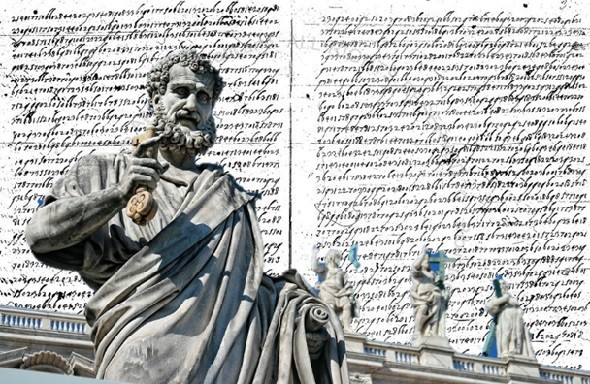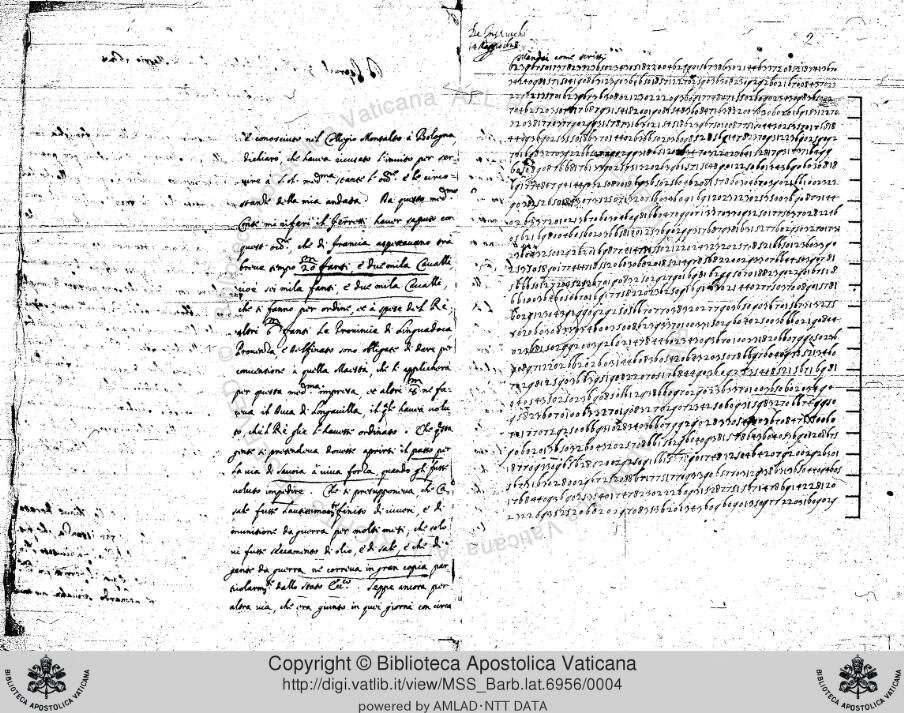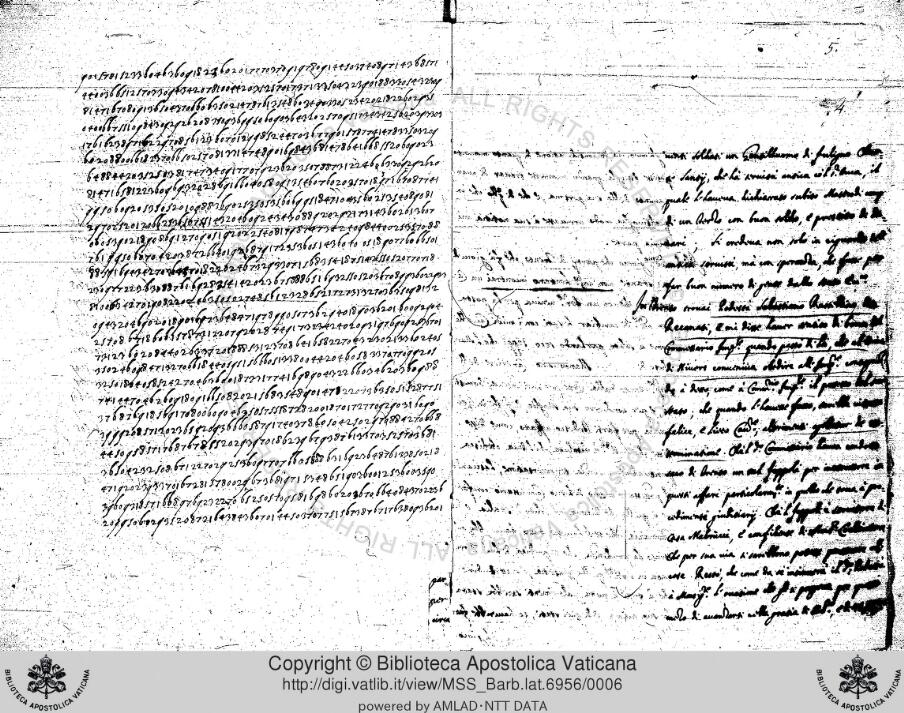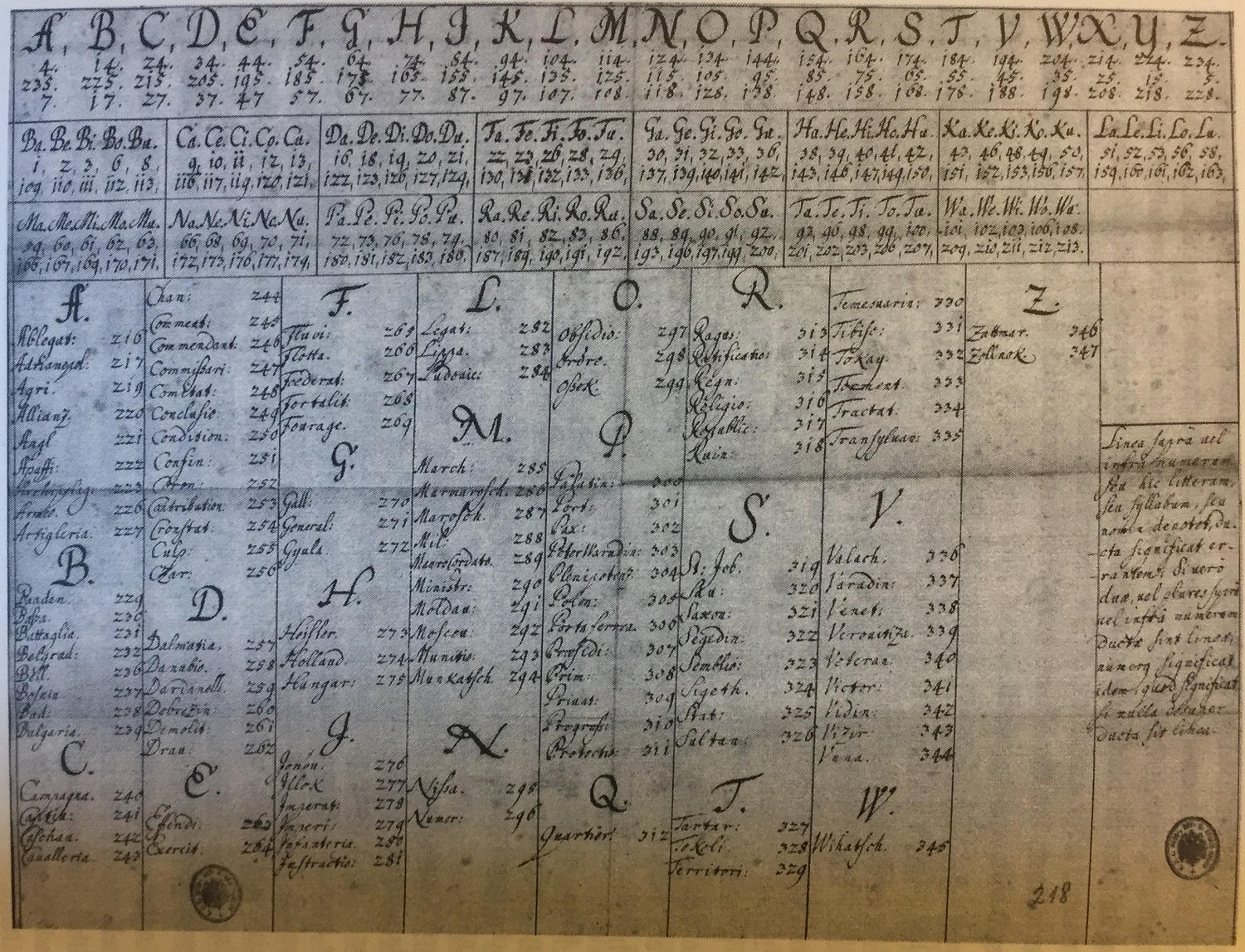The main library of the Vatican owns an encrypted letter from 1628. Can a reader break this cryptogram?
Everybody interested in codebreaking should know MysteryTwister C3 (MTC3), the largest crypto puzzle website in the world.
On MTC3, you can try your luck on hundreds of encryption challenges in four different classes of difficulty: simple (1), medium (2), hard (3), and unsolved (X). Some of the challenges were designed by me. I mainly contributed level 3 and level X challenges – i.e., some of the tough ones. Beginners should start with the level 1 challenges, of course. You will see that most of them are easy to break, even for a layman.
The Vatican Challenge #1
Prof. Bernhard Esslinger, MTC3 steering group member and reader of this blog, has informed me about a challenge that was published on MTC3 in January this year. It’s named Vatican Challenge part 1 (there’s also a second part, which I will cover in a later blog post). The Vatican Challenge part 1 was authored by linguist and crypto history expert Prof. Beáta Megyesi from Sweden. It’s a level X challenge, which means that the solution is not known.
The Vatican owns a large collection of historical writings, including manuscripts, letters, and printed books. Many of these writings are currently digitized to be made available to the public. Some of these old documents contain ciphertexts that have not been deciphered yet. The following three double pages (they probably represent a letter) come from the Biblioteca Apostolica Vaticana, the Main Library of the Vatican:
According to Beáta, these pages were labled with the following information:
Germania: Giovanni Battista Pallotto, Nunzio all’Omp eratore. Cifre del 14 maggio al 29 agosto 1628.
This means that this cryptogram was created in 1628. Giovanni Battista Maria Pallotto (1594-1668) was an Italian cardinal.
What kind of encryption was used?
Beáta Megyesi has transcribed the whole encrypted text. The complete transcription is available for download here. Here’s the transcription of the first page:
# 002r.jpg
<IT De Inenunchi? 14 Maggio 1628.>
6 2 3 9 6 7 5 0 1 7 3 7 8 2 3 3 2 3 6 5 0 2 3 4 3 0 5 1 8 2 2 0 0 4 6 2 3? 9 0 1 5 6 7 3 8 6 3 0 2 1 4 4 6 3 3 7 2 0 8 5 2 1 8 7 4 1 3 6 7 0
3 4 2 4 0 9 8 1 5 7 1 5 0 4 1 9 0 8 6 3 1 2 3 9 0 3 6 0 6 5 0 1 8? 5 7 1 2 2 7 0 2 5 9 0 3 6 3 0 8 2 3 0 9 2 9 2 6 0 2 1 6 7 0 0 8 4 3 7 0 2 3
2 2 0 0 2 5 3 5 7 0 1 6 2 3 9 6 7 3? 6 3 0 8 0 2 1 2 3 0 2 2 2 0 9 3 6 0 9 1 7 7 4 8 4 7 1 5 5 0 2 6 0 9 0 2 3 4 3 0 9 8 3 6 5 0 2? 2?
7 0 4 6 2 5 2 0 3 5 0 7 ? 1 7 6 8 7 9 3 1 5 4 1 8 2 0 0 1 9 0 8 4 5 4 8 3 6 0 8 4 7 1 6 3 8 2 2 0 0 3 6 3 0 6 0 2 0 1 6 9 1 5 3 1 2 2 7 0
3 2 0 3 8 1 7 7 0 3 7 7 9 0 2 9 9 3 1 5 7 8? 7 3 1 6 3 0 2 1 5 4 5 1 8 6 2 3 9 6 7 5 0 1 0 0 8 7 7 5 1 0 0 4 4 3 0 2 5 3 5? 7 0 1 7? 6 8 1 8
4 4 0 9 3 6 9 0 2 5 3 5 5 0 1 8 6 3 7 0 1 4 4 0 2 6 3 6 6 5 0 2 0 3 6 0 9 8 5 2 8 5 6 9 1 4 7 8? 2 3 7 0 9 3 1 2 2 3 6 9 0 2 5 9 0 9 2
7 0 1 6 9 8? 3 2 7 0 3 9 2 2 6 6 5 0 7 7 9 0 2 9 9 3 1 8 6 5 1 2 0 ? ? 3? 4 7 0 3 2 2 0 2 3 6 4 1 5 2 8 1 7 9 3 1 7 3 7 1 6 4 9 9
6 0 5 0 8 9 0 8 7 6 6 8 1 7 6 1 3 3 9 0 2 5 9 3 1 3 2 0 2 6 3 9 6 1 5 7 1 5 0 4 8 9 0 1 2 2 5 0 6 0 1 3 4 3 6 9 0 6 0 3 0 5? 1 8
6 9 1 7 7 4 8 4 7 9 4 1 4 4 9 0 5 2 5 0 8 0 0 1 8 6 9 3 6 5 0 2 5 6 0 4 6 2 0 8? 1 5 7 8 6 0 3 0 4 6 7 0 3 9 0 2 1 6 6 1 0 0 2 3 2 2
9 0 2 5 3 5 2 6 5 0 1 8 4 3 0 7 3 5 2 5 0 7 1 3 2 0 7 6 6 0 3 3 6 0 9 1 6 9 1 2 0 2 3 2 2 3 0 2 5 7? 5 0 0 7? 6 9 0 8 7 3 1 4 4
0 2 6 3 3 7 2 0 1 0 2 1 3 6 7 0 6 0 3 0 4 6 0 9 8 1 6 6 0 4 7 0? 9 9 0 7 1 3 3 7 0 3 3 0 9 3 2 5 0 1 7 7 5 6 3 7 0 2 8 2 2 4 6
0 5 6 2 1 6 9 8 8 0 4 6 0 5 6 0 2 0 3 6 6 5 8 1 0 0 1 2 5 3 6 9 0 2 9 3 1 7 6 8 7 9 3 8 1 6 3 1 5 2 7 7 6 0 2 9 5 0 3 2 7 0 1 7 3 1
2 3 6 0 4 3 2 5 0 0 2 9 2 6 2 0 1 6 9 8 7 7 4 1 4 7 8 4 5 5 0 2 1 2 2 0 2 4 3 2 3 2 0 2 5 7 0 8 5 2 1 6 6 5 0 1 2 3 6 0 3 3 9 0
2 5 7 3? 0 5 8 9 0 1 7 7 4 1 4 7 1 8 5 5 2 0 6 0 3 0 6 0 2 0 1 8 5 2 1 4 9 7 8 5 6 8 2 2 0 0 2 9 3 3 0 7 6 6 4 4 5 0 3 9 0 7 8 1
5 6 6 6 5 0 1 2 7 2 0 3 5 2 5 3 6 7 0 1 9 0 8 3 2 5 0 2 9 2 7 9 0 1 6 9 8 1 6 2 9 9 5 0 7 0 1 8 8 2 3 9 0 2 2 9 0 1 6 7 5 1 8
6 6 1 0 0 3 6 4 6 0 5 0 6 7 0 1 6 9 1 7 7 5 8 2 2 0 2 3 6 2 5 0 9 1 6 9 1 0? 6 3 0 2 1 4 4 0 2 7 7 5 0 3 7 0 0 8 9 0 1 5 7 8 1
6 0 2 9 1 2 3 0 4 3 9 1 9 9 0 9 2 9 2 5 0 5 6 6 7 0 7 7 0 3 8 3 2 0 2 7 7 9 0 3 6 5 0 9 0 3 6 7 0 1 5 6 7 3 1 3 2 5 5
5 0 2 0 6 0 3 0 8 3 3 9 3 4 6 0 0 3 5 0 0 8 6 2 3 9 3 3 7 0 1 0 0 3 3 1 5 0 2 9 6 0 4 0 2 5 0 0 3 6 6 6 0 2 1 9 0 8 4 4
0 2 3 6 8 1 5 0 2 9 9 2 0 0 3 9 2 6 0 2 1 4 7 8 4 4 6 0 2 3 4 3 0 9 3 6 7 0 1 0 0 3 3 1 8 2 0 6 6 0 7 9 9 0 5 0 2 3 6
9 0 8 9 7 1 2 2 0 2 6 6 2 0 2 6 0 3 1 4 4 6 0 8 3 6 0 5 4 2 0 6 4 3 2 0 3 5 0 7 8 6 6 9 7 6 0 4 0 9 3 3? 5 2 1 3 4 6 0
7 0 2 9 8 1 2 5 9 0 3 6 6 3 9 5 1 9 0 8 2 2 0 7 0 5 1 7 6 8 4 4 9 0 3 6 0 9 2 3? 3 5 4 0 8 5 2 1 5 6 7 1 6 9 5? 1
0 4 0 5 4 3 5 0 2 5 0 2 3 6 9 0 8 5 0 6 6 1 2 9 3 8 6 6 0 9 7 0 2 9 0 2 3 6 3 3 7 0 1 0 0 3 6 5 0 6 0 2 0 3 4 9 0
9 5 8 2 3 6 0 7 0 1 0 0 6 3 3 2 7 0 1 9 0 8 3 2 7 0 2 9 0 7 2 3 4 2 5 0 6 0 9 3 1 5 9 8 3 2 7 0 6 6 7 4 9 9 5 0
7 0? 1 7 7 0 7 2 9 2 5 0 0 6 6 9 3 1 0 2 8 3 4 0 3 6 6 0 7 9 9 2 9 0 2 8 3 3 0 5 4 9 ? 0 3 6 7 0 8 4 7 1 5 3? 0 0 6 0
9 0 6 0 2 0 1 3 6 5 0 3 2 6 0 4 3 2 0 2 5 7 0 8 6 6 1 5 0 2 9 6 0 4 0 9 3 8 1 5 7 8 6 4 3 6 0 4 0 5 3 6 9 0 1 2 0 8 6 7 5
1 8 7 7 0 9 3 3 0 9 6 5 6 2 8 9 2 0 0 2 9 2 5 0 9 1 6 6 1 5 6 7 8 9 0 1 7 4 8? 3 2 5 0 4 6 4 2 0 7 9 2 0 0 2 9 2 6 3 0 1
5 6 7 3 1 6 3 0 2 8 0 0 2 9 6? 7 2 5 2 0 8 8 6 7 1 7 7 5 1 7 7 0 9 3 3 9 0 6 5 7 7 0 3 1 2 9 3 8 6 3 1 3 6 5 0 4 4 0 9? 4 6 0 5
1 7 6 8 4 4 0 9 3 6 9 0 2 5 3 5 4 0 1 7 4 7 8 2 3 0 2 2 2 6 0 9 3 1 5 2 8 7 7 5 1 5 6 7 1 4 7 8 6 9 1 4 2 2 8 1 2 0
2 3 2 2 0? 9 3 5 2 5 2 0 6 0 2 0 2 9 7 0 8 3 5 3 6 2 0 1 3 4 3 6 0 9 6 0 9 0 1 3 5 0 9 7 7? 2 2 0 5? 1 6 0 9 0 2 9
As can be seen, the ciphertext consists of a long sequence of digits. There are no separations. This means that the digits need to be read in groups of equal length, probably in pairs. Here’s a similar cryptogram from about the same time.
The encryption of Pallotto’s letter is probably based on an encryption table that assigns a letter or a word or a syllable to each digit group. If the table contains only letters, we deal with a letter substitution (probably a homophonic one, as there are certainly more different digit groups than letters in the alphabet). If the table also lists words or syllables, the cipher used is a nomenclator.
It is known that the Vatican used nomenclators already in the 14th century. So, it would come as no surprise to encounter such a method in the 17th century. It is difficult to break a well-designed nomenclator. However, many nomenclators were not well-designed. For instance, many used low numbers for letters and high numbers for words. In many nomenclators the entries are sorted, like A=11, B=12, C=13, which makes the cipher easier to use but is less secure. The following picture shows a nomenclator (taken from the paper Briefe durch Feindesland published by Gerhard Kay Birkner in the proceedings of the conference Geheime Post in 2015; it’s, of course, not the one used here):
If you have a clue about these encrypted texts, please leave a comment. However, please don’t publish the solution here. If you know the solution, please register at MTC3 and hand it in. You will receive many points for solving a level X challenge.
Follow @KlausSchmeh
Further reading: An unsolved message sent to Robert E. Lee
Linkedin: https://www.linkedin.com/groups/13501820
Facebook: https://www.facebook.com/groups/763282653806483/







Kommentare (19)